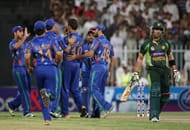We’ve seen some riveting Test cricket in recent times, but overall, the incentives are far too less to make Test cricket competitive
The proposed World Test Championship (WTC) was bound to be a failure. First scheduled to begin in 2013, the tournament was shifted four years ahead after receiving a lukewarm response from sponsors and fans alike.
Despite some of the best Test cricket being played over the last few years, the WTC may finally have received its knockout punch after reports of the ICC mulling over bringing the Champions Trophy back began doing the rounds.
The Champions Trophy, in all practicality, is a pointless tournament where large wads of cash are thrown for the purpose of constructing a large spectacle for very little reason. That the ICC is thinking about bringing the tournament back to replace the unrealised Test Championship is perceptive of a threatening lack of creativity and enterprise with the men in suits.
Changing times and shorter formats
Cricket has often been criticised for not being able to keep up with the changing times. Traditionally, the sport is meant to be taken in slowly, and allowed to marinate within the individual’s consciousness to bring out the true nature of the game. But with commercialization and the industry taking over all aspects of the world, cricket has always needed to expand to attract a wider audience and continuously satiate their needs.
Test cricket has been hurt after the introduction of the T20 game, and more so after the IPL came into the fore. Time indeed is money, and the more we spend it in activities outside of the television box, the more satisfying life turns out to be. Spending five days in front of a television has become the benchmark for defining someone a ‘cricket enthusiast’, when in truth the Test format is what cricket was originally all about.
Where’s the prize in Test cricket?
The culture of a Test series or a One Day series has silently been embedded into the cricketing parts of our mind, and that consequently has formed our perception of the game. Through all the closely fought five-match Test series and even the recent Ashes-like landslide, there is a need to understand that nothing really is at stake.
The cricket rankings, with its complex system of points distribution and general lack of appeal to the viewer, fail to rouse any kind of emotion or thirst of a higher incentive in players. There may well have been a time when victory would have bequeathed honour and pride in those victorious, but today that is not enough. This is where cricket, Test cricket in particular, has fallen behind.
The IPL’s round-robin format instantly appeals to everyone; not only because teams compete over a far lesser time period, but also because the mega-sized incentives that urge players on to snarl and stare at their opponents to win a game capture the attention of the masses in ways cricket has never experienced.
Test cricket is a dying sport. But in no way can we allow it to die. Cricket needs viewers, because cricket needs money. And cricket gets money from its sponsors. But unless there are no viewers, there will be no sponsors. What cricket can offer most are promises. But Test cricket’s promises so far have not been enough to shake the system.
The two-tier Test cricket
The recent debate to form a league of Test teams has piqued the interest of a large segment of the audience. Taking an example from football, the various leagues that are played all over the world have sustained themselves precisely because of this format. Not only that, but the idea of a team being relegated and another promoted adds another dimension of excitement to the game.
To imagine New Zealand and West Indies battling for survival, while India and South Africa try to go one up on each other is a tantalizing prospect. The idea of relegations and promotions, however, isn’t a revolutionary one for cricket. It’s used in the Ranji Trophy, as well as the English County format, and although domestic cricket is not nearly as popular as domestic football, there is a certain tenacity in the game that is enough to excite any sports fan.
In 2011, Lancashire won the County first division by a good eleven points, only to be relegated immediately the year after that. That risk and unpredictability factor triples the aforementioned pride and honour in winning a game apart from setting a set incentive for teams to chase, which definitely brings in the audience in large numbers.

The two-tier system will bring new opportunities for smaller cricketing nations like Afghanistan and Ireland
To add to that, we could have teams like Ireland and Afghanistan, who have made their marks in the limited overs game, rub shoulders with the best sides in the world. There’s a huge amount of incentive for teams from a lower division to win if this format comes into play.
Test cricket is an intelligent game that requires intelligent execution, not only on the field, but off it as well. So far, there has been a depressing lack of ideas and initiative taken by the ICC to revive the oldest format of the game and give it the status it deserves.
This proposed change would hopefully usher in an entirely new structure to the game and create completely new windows for the average cricket viewer to assess the game.
With extra points attached to things like making the opponents follow-on, or scoring 300 or more runs in a single day, the intensity of the game will increase and introduce to us the revolution Test cricket has long been waiting for.
Brand-new app in a brand-new avatar! Download CricRocket for fast cricket scores, rocket flicks, super notifications and much more! 🚀☄️
